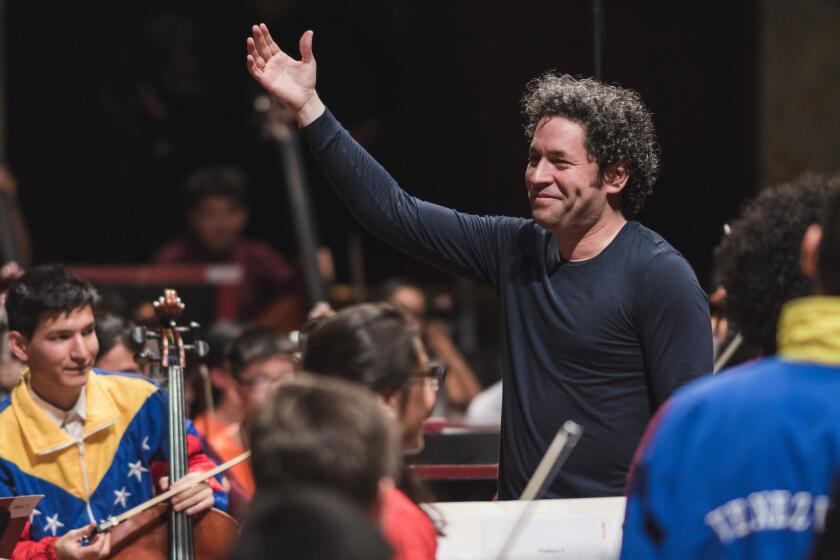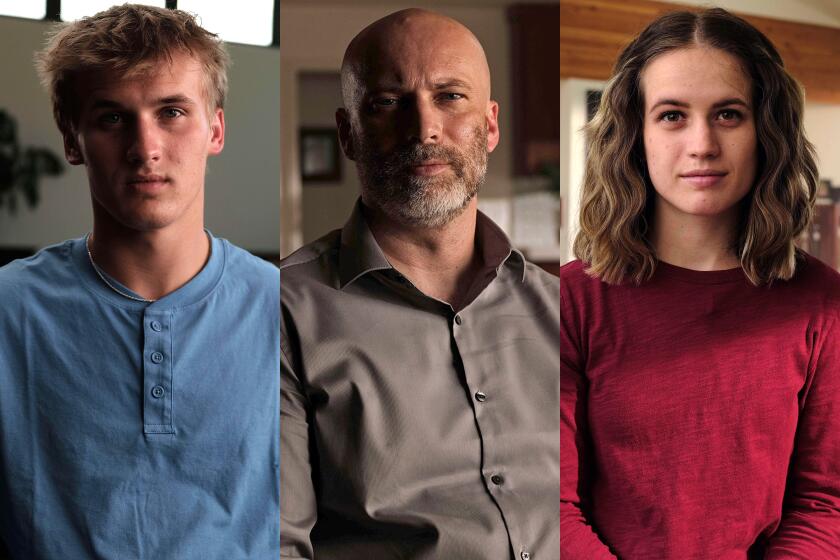First Woman Joins Vienna Philharmonic
- Share via
VIENNA, Austria — The Vienna Philharmonic Orchestra, bowing to the pressure of threatened boycotts and demonstrations in Costa Mesa and New York City, ended 155 years of tradition Thursday by admitting one woman to its illustrious all-male ranks and voting to audition others beginning this summer.
The decisions came on the eve of an international tour that brings the world-renowned orchestra to the Orange County Performing Arts Center and Carnegie Hall--the only two U.S. stops on the tour--next week. Women’s groups, who plan protests at both halls against the orchestra’s historic refusal to admit female musicians, welcomed the turnabout but said it won’t halt their demonstrations.
“This is a step in the right direction, and the orchestra is to be congratulated if it is sincere in opening the auditioning process,” said JoAnn Perlman of the south Orange County chapter of the National Organization for Women, which is organizing the protests with the International Alliance for Women in Music.
“But our peaceful demonstration will go forth as planned as a way to raise public consciousness of the issues. This includes the admission of minorities as well as women,” Perlman said. “Our whole purpose is to recognize diversity, which can be cultural and ethnic and can have to do with sexual orientation as well as gender.”
Following Thursday’s vote--which did not address the issue of admitting members of racial or ethnic minorities--the philharmonic granted full membership to harpist Anna Lelkes. Because of a critical shortage of male harpists, Lelkes, 57, has been allowed to play with the orchestra for more than 20 years, but had not been admitted formally.
It wasn’t until March 1995 that her name first appeared on a concert program, for a performance at Carnegie Hall.
“I think the action they’ve taken is the best possible thing that could happen,” said Dean Corey, executive director of the Philharmonic Society of Orange County, which is spending at least $300,000 to sponsor the orchestra’s concerts Wednesday and Thursday in Costa Mesa.
“We’ve maintained that this is an Austrian issue and, more specifically, an issue for this particular orchestra,” Corey said. “Well, they’ve taken the issue and solved it, just as they’ve solved everything else since their inception.”
Critics of the orchestra were less sanguine Thursday.
“This is a breakthrough, a big step forward, but I still want to wait to see what will really happen,” said Regina Himmelbauer, a music historian who has been attempting to rally the protest from Vienna. “I hope the harpist will not be the [token] woman.”
Under the terms of Thursday’s decision, women will be able to audition for several string and brass positions that come open this summer. But those who audition successfully still would have to complete a three-year probation period with the Vienna State Opera orchestra before applying to the philharmonic. All members of the privately run philharmonic are chosen from the government-financed opera orchestra.
But neither orchestra will change its audition procedures, philharmonic president Werner Resel said in an interview. Critics had argued that final auditions should be conducted behind screens, as early round auditions are, to obscure race and gender. But final rounds still will be held without the screens in almost all cases.
And aspiring members still will be required to include photographs with their applications and resumes, Resel said.
The procedures will remain even though both orchestras issued a statement that they had decided “effective immediately, musicians of both sexes will have equal chances for becoming members of the Vienna Philharmonic.”
Critics charge that in addition to deliberately excluding women, the Vienna Philharmonic discriminates against ethnic minorities. All its members are white Central European men. Two members--father and son violinists--are Jewish, according to orchestra officials.
The orchestra maintains that its “homogeneity” gives the ensemble its unique and valued sound. Resel insisted that selections of new members are made only on the basis of artistic talent, as well as the ability to “be integrated into our community.”
Other members of the philharmonic have argued that women would change the sound of the music, or that prolonged maternity leaves would erode quality.
“The only pressure we feel is our own quality,” said Resel, a cellist.
In fact, Austria’s center-left government, chagrined at the bad publicity it was receiving, had become increasingly assertive in demanding that the orchestra end its ban on women members.
Resel said a change in labor regulations, agreed to on Thursday with government officials, helped facilitate the new policies. Austrian law entitles women to two-year maternity leaves with pay; the new rules will allow men and women to take the leaves, permit the placement of substitute players and require returning musicians, male and female, to try out before a jury.
The orchestra’s detractors, as well as some government officials, have maintained that the pregnancy issue was a smoke screen.
Earlier this month, Austria’s director general for the arts, Andreas Mailath, said international public opinion--”especially from America”--and “inquiries and demands in our parliament” had helped state opera director Ioan Holender force the orchestra to deal with an issue that had been brewing for decades.
Of the approximately 90 men attending Thursday’s orchestral General Assembly of musicians, a “good majority” voted in favor of opening membership to women, Resel said. But he refused to release the breakdown of the vote. The philharmonic has approximately 140 members.
While praising the belated inclusion of harpist Lelkes, organizers of demonstrations scheduled outside the Orange County center and Carnegie Hall cautioned that the orchestra has a long way to go to end its discriminatory practices.
“At this point the Vienna Philharmonic has not disbanded [its] all-male ideology, which will take some time,” said Catherine Pickar, a music professor at George Washington University in Washington, D.C., and a spokeswoman for the International Alliance for Women in Music.
“Until we see visible results, we will keep up” the protest, she said.
A spokeswoman for Carnegie Hall denied a report in the Austrian press that the hall might ban the orchestra in the future unless it admits women.
“There has been a lot of discussion of what the orchestra has been going through,” Jennifer Wada, Carnegie Hall director of publication relations, said Thursday. “Insofar as demonstrations and women’s admission is an important issue, it was discussed seriously by the staff and the board as a matter of business. But we never came to the conclusion to possibly ban the orchestra if it did not admit women.”
Carnegie Hall also denied reports that there were ticket cancellations to the upcoming concerts.
The Philharmonic Society of Orange County reported last week that although it has received a few calls and letters about the Vienna Philharmonic’s exclusionary policy, there have been no cancellations for the sold-out concerts in Costa Mesa.
State opera director Holender indicated earlier this year that women would be allowed to audition for the first available spots, which could lead to women eventually being funneled into the philharmonic. But the philharmonic’s acquiescence represented the removal of an important barrier.
“I think it’s wonderful,” Agnes Grossman, who became the first woman director of the Vienna Choir Boys last year, said from Canada, where she was touring. “It creates a lot of new courage and new hope for the future of Austria.”
Elena Ostleitner, a musicologist at Vienna’s University of Music, greeted the news with skepticism. “At least women will be able to audition now,” said Ostleitner, who has championed the cause for the past 18 years. “It’s been a very long process, and I cannot believe the attitudes will change overnight.”
The president of the Orange County Musicians Assn., Local 7 of the American Federation of Musicians, which had decided not to support the protest against the orchestra, said Thursday that “from the union’s point of view” the admission of women is “a good thing.”
“We just thought that discussions about all of this shouldn’t take place on the sidewalk in front of the hall,” Frank Amoss said. “My personal reaction to the orchestra is, ‘Welcome to the 20th century.’ ”
Noting the imminent arrival of the 21st century, Amoss added: “They’re still about a century behind.”
(BEGIN TEXT OF INFOBOX / INFOGRAPHIC)
Vienna History
March 28, 1842: Vienna Philharmonic Orchestra, then called the Philharmonic Academy, gives its first concert.
Circa March 1938: Following Austria’s annexation by Germany, the Nazi Party dissolves Vienna Philharmonic Society; revered German conductor Wilhelm Furtwaengler intervenes and decision is reversed.
Feb. 21, 1981: Orchestra’s exclusion of women makes headlines in the Austrian press: “The Door Is Open: A Bastion of Male Rule Is About to Fall.”
August 1995: Several female members of Austrian parliament make a political issue of the exclusion of women from the orchestra.
Nov. 15, 1996: Monique Buzzarte, a trombonist from New York City, creates a “Zap the VPO” Web site on the Internet, galvanizing support for protests over the orchestra’s impending U.S. concerts. The Internet becomes the chief means of communication for protest organizers.
January 1997: Director of Vienna State Opera orders that auditions be open to women in the State Opera orchestra, from which the philharmonic members are chosen.
Feb. 20, 1997: Werner Resel, president of the Vienna Philharmonic, says the orchestra should disband rather than give in to pressure to admit women.
Feb. 27, 1997: Vienna Philharmonic agrees to admit women on the day it leaves for an international tour that will bring it to New York City and Costa Mesa.
More to Read
The biggest entertainment stories
Get our big stories about Hollywood, film, television, music, arts, culture and more right in your inbox as soon as they publish.
You may occasionally receive promotional content from the Los Angeles Times.











